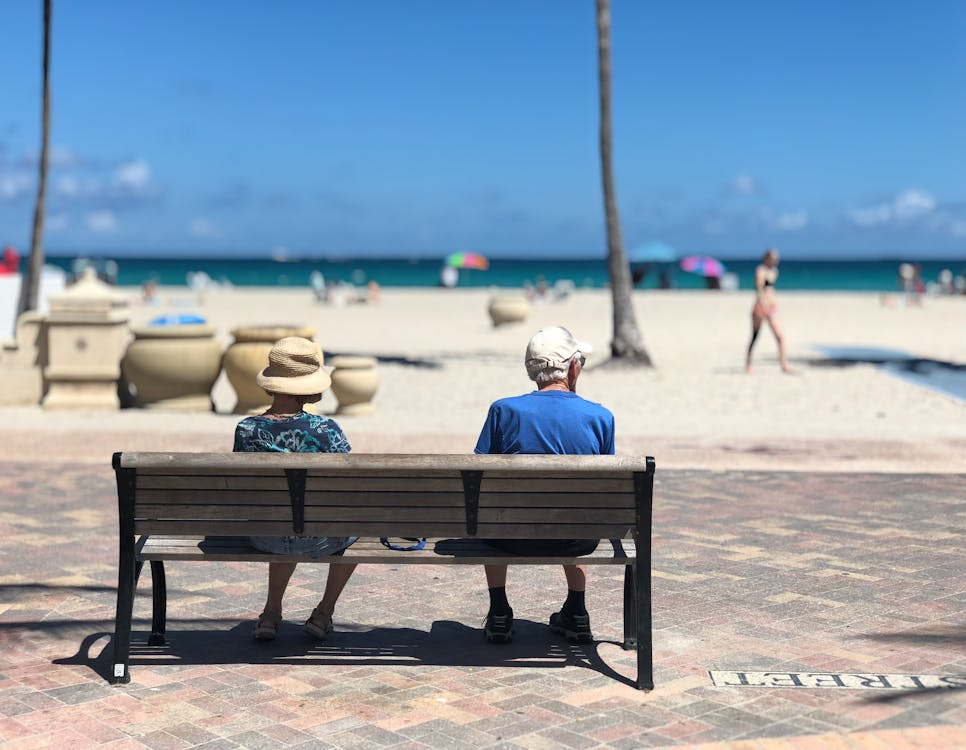
When Lizzie and Joe Sabo swapped Brisbane’s bustle for a small town in Queensland’s Granite Belt, their friends thought they’d lost their minds.
What started as weekend gardening trips to Glen Aplin soon turned into a full-scale lifestyle overhaul—complete with a New Year’s Eve phone call that changed everything.
‘He laughed and said, “It’s about time”,’ Lizzie recalls of her boss’s reaction when she quit her city job.
Now, the Sabos spend their days tending to fruit trees and community projects instead of battling traffic, and they haven’t looked back.
‘Life’s busy in a different way now, and it’s meaningful,’ Lizzie says. ‘We don’t miss the city for a second.’
Their story is part of a growing movement among older Australians embracing regional living.
Fresh data from Citro’s 2025 Australia’s Top 50 Retirement Locations guide—released in partnership with AMP—reveals that more than one in three Australians over 50 are seriously considering relocating once they retire.
Nearly four in ten downsizers are already choosing regional towns over major cities, citing affordability, lifestyle, and a renewed sense of community as driving factors.
The nation’s retirement hotspots revealed
Researchers analysed 300 regional communities with populations above 10,000 to identify Australia’s best places to retire.
Orange in New South Wales claimed the top spot for 2025, offering the perfect mix of rural charm and modern convenience.
With a median dwelling price of $665,000, the thriving inland city delivers value for money alongside big-city comforts.
Orange also offers essentials many retirees prioritise—an airport for domestic and international travel, a state-of-the-art hospital, and strong transport connections across the state.
Beyond practicality, Orange is booming with investment, with $358.5 million worth of new projects set to begin in 2025.
Plans include 444 lots, 69 dwellings, 63 units or apartments, and 16 townhouses—proof of the area’s steady growth and housing diversity.
‘Australians over 40 are asking smart questions about where they'll spend the next chapter of their lives. It's about matching the practical with the aspirational to find the right place to really thrive in retirement.’
Second place went to Rosebud on Victoria’s Mornington Peninsula, where retirees enjoy the coastal lifestyle without the multimillion-dollar price tags of neighbouring suburbs.
With a median dwelling price of $769,000, Rosebud’s charm lies in its relaxed atmosphere and accessibility to Melbourne.
By contrast, last year’s winner, Armidale in NSW, slipped to just inside the top 20 due to limited housing availability—a reminder of how quickly regional markets shift as demand grows.
What’s driving the great regional migration
This migration trend is fuelled by both emotional and financial motivations.
Despite regional property prices rising by 49.9 per cent since the pandemic and nearly doubling over the past decade, regional homes still offer far better value than their city counterparts.
‘Downsizing is no longer a “last resort” but more so a lifestyle upgrade,’ explains Johanna Urrutia, Co-CEO of OpenAgent. ‘With less upkeep, no dependents and a healthy slice of equity unlocked, this next chapter can be some of the best years of your life.’
The McGrath Report 2025 also found ongoing demand in lifestyle hubs like the Central Coast, Byron Bay, Orange and Tamworth—areas that balance affordability with community appeal.
The gold-plated retirement destinations
Citro’s guide introduced a new category this year—10 ‘gold-plated’ destinations offering premium lifestyles without the sky-high prices of their famous neighbours.
Ballina in NSW topped the list for providing ‘the feel of Byron Bay without the crowds’, while Queensland’s Coolangatta and Coolum Beach combined coastal beauty with a relaxed, community-first feel.
Healthcare and infrastructure matter more than ever
For retirees, access to healthcare remains a non-negotiable.
The research showed that top-ranking towns all share one common feature: excellent medical facilities and transport links.
Orange’s retirement villages, for example, are only five minutes from the town centre and close to essential services.
Essential retirement location features
- State-of-the-art medical facilities and hospitals
- Regular public transport links to major cities
- Airport access for visiting family
- Strong local economy supporting services
- Active cultural scene and community groups
- Reasonable cost of living
The study evaluated five main criteria: housing affordability, availability, healthcare access, transport, and lifestyle.
This balanced approach ensures financial realities align with the everyday needs of older Australians seeking security and fulfilment in their later years.
Coastal versus inland: different dreams, same fundamentals
Coastal retirees often want to feel like ‘every day is a holiday’ without losing access to healthcare or modern conveniences.
Popular sea-change destinations include Ballina, Yamba and Tuncurry in NSW; Brighton, Rosebud and Paynesville in Victoria; and Hervey Bay, Port Douglas and Coolangatta in Queensland.
Meanwhile, tree-changers lean towards budget-friendly inland hubs with cooler climates, space for gardens, and vibrant local arts scenes.
‘Budget often tips the scales, as inland hubs within a two-hour drive of capital cities usually offer more bang for your buck,’ Urrutia says.
Top inland favourites include Armidale, Bellingen and Katoomba in NSW; Beechworth, Echuca and Maryborough in Victoria; and Tamborine Mountain, Stanthorpe and Milton in Queensland.
The numbers tell a compelling story
Regional NSW home values rose by 3.2 per cent in 2024—steady and sustainable compared to the volatility of capital city markets.
OpenAgent data shows 63 per cent of downsizers still stay metropolitan, but key states like NSW (46 per cent), Queensland (42 per cent) and Western Australia (43 per cent) are leading the regional trend.
Melbourne remains the outlier, with 80 per cent of downsizers staying urban, drawn by its cultural richness and world-class amenities.
Making the move: practical considerations
For those ready to make their own move, experts recommend a few must-haves: coastal village charm, flat walking paths, reliable internet, and access to hospitals or medical centres.
Ben Hillier, AMP’s director of retirement, said modern retirees are seeking far more than just financial stability.
‘Australians are telling us they want retirement to be about more than just making ends meet—they're looking for confidence, community and choice.’
Financially, the benefits can be substantial.
Moving regionally allows retirees to unlock equity from city homes while reducing day-to-day costs—a win-win that offers both freedom and fulfilment.
As housing and living expenses continue to climb, the regional lifestyle promises not only savings but also renewed purpose and wellbeing.
For Lizzie and Joe Sabo, that spontaneous New Year’s Eve decision became the start of their best chapter yet.
What This Means For You
Orange, NSW, has been named Australia’s top retirement location for 2025, praised for its balance of affordability, strong healthcare, and modern amenities. The findings come as more than one in three Australians over 50 consider relocating for retirement—many in search of a simpler, more connected lifestyle.
With healthcare access and transport links ranking among the most important factors for retirees, regional towns like Orange, Rosebud, and Ballina are becoming increasingly attractive. Whether you dream of the coast or the countryside, the message is clear—retirement today is about finding a place that feels both affordable and fulfilling, where you can truly enjoy the years ahead.
While many are finding their dream lifestyle in regional towns, others are discovering that the road to a comfortable retirement isn’t always so simple.
Rising living costs, limited super balances, and uncertain housing options can turn what should be a relaxing chapter into a financial balancing act.
If you’ve ever wondered what happens when retirement plans don’t go as expected, this next story sheds light on a growing concern.
Read more: Retirement ‘Nightmare’: Why Millions of Australians Could Be Stuck Relying on the Age Pension
Orange Retirement Village, NSW—Oak Tree Group — Details the amenities and location advantages of Orange, including its airport, hospital, and transport links, as well as proximity to essential services.
https://www.oaktreegroup.com.au/location/orange/
Orange Harbour Property Market Update 1st Half 2025 — Reports $358.5 million worth of new projects planned for 2025, including 444 lots, 69 dwellings, 63 units or apartments, and 16 townhouses.
https://www.prd.com.au/orange/research-hub/article/orange-market-update-1st-half-2025/
Best regional NSW areas for property investment 2025—OpenAgent — Highlights property price growth of 49.9 per cent since the pandemic and ongoing demand in lifestyle hubs like the Central Coast, Byron Bay, Orange, and Tamworth.
https://www.openagent.com.au/blog/best-regional-nsw-areas-for-property-investment
Would you consider trading the city for a regional lifestyle in your retirement years?







